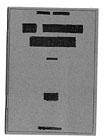
Roland Topor (1938 -1997)
title page from book 'souvenirs'
A small book that has all text barred
De Harmonie- Amsterdam
title page from book 'souvenirs'
A small book that has all text barred
De Harmonie- Amsterdam

second page from the book
Alphabet schema
-a key to the history of mankind-
by David Diringer - volume 2
Alphabet schema
-a key to the history of mankind-
by David Diringer - volume 2
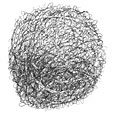
Serge Onnen
Mondonnen
pencil on paper-2007
{21 x 21 cm)
Mondonnen
pencil on paper-2007
{21 x 21 cm)

Marcus Raetz
page from sketchbook
Schreiben- 1973
page from sketchbook
Schreiben- 1973

Christian Dotremont (1922-1979)
Drawing on Finnish newspaper
1965
Drawing on Finnish newspaper
1965
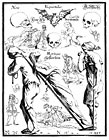
anonymous
N (like in Necro?)
German 17C
N (like in Necro?)
German 17C
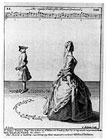
Kellon Tomlinson
Dance notation
Groundplan with figures, 1727
Dance notation
Groundplan with figures, 1727
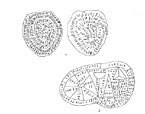
Etruscan tablet

Carl Ferrero
2007
2007

Trisha Brown
1976
on the bottom of the drawing is the alphabet, all the lines refer
to the place in the text about movement.
1976
on the bottom of the drawing is the alphabet, all the lines refer
to the place in the text about movement.

Robert Walser (1878-1956)

In the beginning of 1929, Walser, who had suffered from anxieties and hallucinations for quite a time, went to the Bernese mental home Waldau, after a mental breakdown, at his sister Fani's urging. In his medical records it says: "The patient confessed hearing voices." Therefore, this can hardly be called a voluntary commitment. While in the mental home, his state of mind quickly returned to normal, and he went on writing and publishing. More and more, he used the way of writing he called the "pencil method": He wrote poems and prose in a diminutive Sütterlin hand( Sütterlin for short, is the last widely used form of the old German blackletter handwriting ("Spitzschrift"). In Germany, the old German cursive script developed in the 16th century is also sometimes called Fraktur the letters of which measured about a millimeter of height by the end of that very productive phase.) Werner Morlang and Bernhard Echte were the first ones who attempted to decipher these writings. In the 1990s, they published a six-volume edition, Aus dem Bleistiftgebiet ('From the pencil area'). Only when Walser was, against his will, moved to the sanatorium of Herisau in his home canton Appenzell Ausserrhoden, did he quit writing. Another reason might have been that with the rise of the Nazis in Germany, his works could no longer be published in any case. (source Wiki)

Seven kinds of shorthand
The Lord's prayer in Gregg and a variety of 19th-century systems
Shorthand is an abbreviated and/or symbolic writing method that increases speed or brevity of writing as compared to a normal method of writing a language. The process of writing in shorthand is called stenography, from the Greek stenos (narrow) and graphē (writing). It has also been called brachygraphy, from Greek brachys (short) and tachygraphy, from Greek tachys (swift, speedy), depending on whether compression or speed of writing is the goal. Many forms of shorthand exist. A typical shorthand system provides symbols or abbreviations for words and common phrases, which allow someone well trained in the system to write as quickly as people speak.
Shorthand was used more widely in the past, before the invention of recording and dictation machines. Until recently, shorthand was considered an essential part of secretarial training as well as being useful for journalists. Although the primary use of shorthand has been to record oral dictation or discourse, some systems are used for compact expression. For example, health-care professionals may use shorthand notes in medical charts and correspondence. Shorthand is also common in the food service industry, allowing wait staff to write down detailed orders without delay.
(Source Wiki)
The Lord's prayer in Gregg and a variety of 19th-century systems
Shorthand is an abbreviated and/or symbolic writing method that increases speed or brevity of writing as compared to a normal method of writing a language. The process of writing in shorthand is called stenography, from the Greek stenos (narrow) and graphē (writing). It has also been called brachygraphy, from Greek brachys (short) and tachygraphy, from Greek tachys (swift, speedy), depending on whether compression or speed of writing is the goal. Many forms of shorthand exist. A typical shorthand system provides symbols or abbreviations for words and common phrases, which allow someone well trained in the system to write as quickly as people speak.
Shorthand was used more widely in the past, before the invention of recording and dictation machines. Until recently, shorthand was considered an essential part of secretarial training as well as being useful for journalists. Although the primary use of shorthand has been to record oral dictation or discourse, some systems are used for compact expression. For example, health-care professionals may use shorthand notes in medical charts and correspondence. Shorthand is also common in the food service industry, allowing wait staff to write down detailed orders without delay.
(Source Wiki)

Tiago Estrada
2005 pencil on paper
2005 pencil on paper

Shakers giftdrawing
The United Society of Believers in Christ's Second Appearing – called "Shakers" – originated in England in the mid-eighteenth century and soon centered around the person of Ann Lee (Mother Ann, or Mother Wisdom, or simply Mother), who became "the reincarnation of the Christ Spirit … Ann the Word … Bride of the Lamb." The group practiced communal living and equality of the sexes, along with a reputedly complete abstention from sexual intercourse. After persecutions and jailings in England, Ann brought them to America in 1774, where for many years they thrived on conversions, reaching a maximum size of 6,000 before their demise in the twentieth century.
Strict believers in celibacy, Shakers maintained their numbers through conversion and adoption of orphans. Turnover was very high; the group reached maximum size of about 6,000 full members in 1840, but now has only four members left.
Between 1837 and 1850 ("known as the Era of Manifestations") the Shakers composed (or were the recipients of) "hundreds of … visionary drawings … really [spiritual] messages in pictorial form," writes Edward Deming Andrews (The Gift To Be Simple, 1940). "The designers of these symbolic documents felt their work was controlled by supernatural agencies … – gifts bestowed on some individual in the order (usually not the one who made the drawing." The same is true of the "gift songs" and other verbal works, and the invention of forms in both the songs and drawings is extraordinary, as is their resemblance to the practice of later poets and artists.
This drawing is a very long prayer that was used in services
N.B. "To be sure, the term drawing is a misnomer, because the Shakers did not use it themselves when they were referring to these works. In the few Shaker documents in which the gift drawings are mentioned, they are typically referred to as sheets, rolls, signs, notices, tokens of love, presents, rewards, hearts – sometimes prefaced by the adjective sacred. This definition focuses on the function of the works as gifts from heavenly spirits, rather than on the form in which the gifts were materialized. In fact, the gift drawings often include titles, captions, inscriptions, and extended texts, in English as well as in scripts written in indecipherable tongues, that place them on an uninterrupted continuum with other manifestations of belief, such as inspired writing, ecstatic movement, and spontaneous speech, especially in the form of song." (Thus: France Morin, in Shaker Gift Drawings and Gift Songs, The Drawing Center, New York, and UCLA Hammer Museum, 2001 – a book packed with generous examples, from which those shown here have been extracted.)
(source wiki & ubuweb)
The United Society of Believers in Christ's Second Appearing – called "Shakers" – originated in England in the mid-eighteenth century and soon centered around the person of Ann Lee (Mother Ann, or Mother Wisdom, or simply Mother), who became "the reincarnation of the Christ Spirit … Ann the Word … Bride of the Lamb." The group practiced communal living and equality of the sexes, along with a reputedly complete abstention from sexual intercourse. After persecutions and jailings in England, Ann brought them to America in 1774, where for many years they thrived on conversions, reaching a maximum size of 6,000 before their demise in the twentieth century.
Strict believers in celibacy, Shakers maintained their numbers through conversion and adoption of orphans. Turnover was very high; the group reached maximum size of about 6,000 full members in 1840, but now has only four members left.
Between 1837 and 1850 ("known as the Era of Manifestations") the Shakers composed (or were the recipients of) "hundreds of … visionary drawings … really [spiritual] messages in pictorial form," writes Edward Deming Andrews (The Gift To Be Simple, 1940). "The designers of these symbolic documents felt their work was controlled by supernatural agencies … – gifts bestowed on some individual in the order (usually not the one who made the drawing." The same is true of the "gift songs" and other verbal works, and the invention of forms in both the songs and drawings is extraordinary, as is their resemblance to the practice of later poets and artists.
This drawing is a very long prayer that was used in services
N.B. "To be sure, the term drawing is a misnomer, because the Shakers did not use it themselves when they were referring to these works. In the few Shaker documents in which the gift drawings are mentioned, they are typically referred to as sheets, rolls, signs, notices, tokens of love, presents, rewards, hearts – sometimes prefaced by the adjective sacred. This definition focuses on the function of the works as gifts from heavenly spirits, rather than on the form in which the gifts were materialized. In fact, the gift drawings often include titles, captions, inscriptions, and extended texts, in English as well as in scripts written in indecipherable tongues, that place them on an uninterrupted continuum with other manifestations of belief, such as inspired writing, ecstatic movement, and spontaneous speech, especially in the form of song." (Thus: France Morin, in Shaker Gift Drawings and Gift Songs, The Drawing Center, New York, and UCLA Hammer Museum, 2001 – a book packed with generous examples, from which those shown here have been extracted.)
(source wiki & ubuweb)

Shakers giftdrawing (detail)

Shakers giftdrawing (detail)

Shakers giftdrawing (detail)

Shakers giftdrawing (detail)

Shakers giftdrawing (detail)

Shakers giftdrawing (detail)

Shakers giftdrawing (detail)

Shakers giftdrawing (detail)

Trenton Doyle Hancock
Courtesy James Cohan Gallery, NYC
Courtesy James Cohan Gallery, NYC
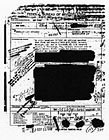
FBI document
Unkown master 1948
Unkown master 1948

Gustave Flaubert (1821-1880)
first version of 'trois contes; la Legende de saint Julien'
Bibliotheque nationale de France
first version of 'trois contes; la Legende de saint Julien'
Bibliotheque nationale de France

Gustave Flaubert (1821-1880)
first version of 'trois contes; la Legende de saint Julien'
Bibliotheque nationale de France

Napoleon Bonaparte
Document written in code by Napoleon to his minister of war
Musee des lettres et manuscipt, paris
Document written in code by Napoleon to his minister of war
Musee des lettres et manuscipt, paris

Roland Topor
Lettre to monsieur
1964
Lettre to monsieur
1964

Dominic McGill
Courtesy Derek Eller gallery
Courtesy Derek Eller gallery

Dominic McGill
Courtesy Derek Eller gallery
Courtesy Derek Eller gallery

Tanja Smit
Drawing on El Pais
2005
Drawing on El Pais
2005

Kinke Kooi
Courtesy Features inc. NYC
Oh, Soul
2006
Courtesy Features inc. NYC
Oh, Soul
2006

Voebe de Gruyter
coiffeur islamique
2006
coiffeur islamique
2006

Roland Barthes 1915-1980
Contre écriture adressée a R. Sulger-Buel
Contre écriture adressée a R. Sulger-Buel

CIA
Confidencial document from the Contemporary Infotainment Artschool
Confidencial document from the Contemporary Infotainment Artschool
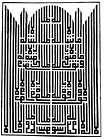
Quran Calligraphy
Turkish 16C
Turkish 16C

Henri Jacobs
journaal tekening 2006
Courtesy Gallery Paul Andriessen, Amsterdam
journaal tekening 2006
Courtesy Gallery Paul Andriessen, Amsterdam
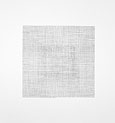
Christopher McNulty
20,534 Days
2006
18" x 18"
20,534 Days
2006
18" x 18"

Xu Bing
Landscript 2001
Ink on Nepalese paper
Landscript 2001
Ink on Nepalese paper
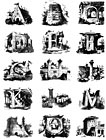
Unknown
french roman-achitecture font
french roman-achitecture font

Unknown
french roman-achitecture font
french roman-achitecture font
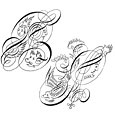
John Seddon
1695
UK
1695
UK

Unknown 1943
Franklin Delano Roosevelt
Pre-computer Ascii art
Franklin Delano Roosevelt
Pre-computer Ascii art
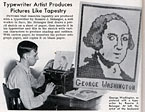

French Rebus 1859
These extremely difficult rebuses where very popular in illustrated magazines around 1840-1890.
This one means; L'homme qui tient la table pendant quatre heures en sort la panse arrondie'
What is in French something like; "si l on passe beaucoup de temps a table, on ne doit pas s etonner d'avoir un gros ventre !'
What is in English something like; 'The man who spends a lot of time at a dinner table should not be supriced to leave the table fat'
The man who holds the table during 4 hours. (he says- 'I will drop it at noon')
En sort- coming out (note the old 1859 walking with a stick)
La panse - Lapancha - Don Chixote helper
Arrondie- Un rond d'i - a cirle of i's
This one means; L'homme qui tient la table pendant quatre heures en sort la panse arrondie'
What is in French something like; "si l on passe beaucoup de temps a table, on ne doit pas s etonner d'avoir un gros ventre !'
What is in English something like; 'The man who spends a lot of time at a dinner table should not be supriced to leave the table fat'
The man who holds the table during 4 hours. (he says- 'I will drop it at noon')
En sort- coming out (note the old 1859 walking with a stick)
La panse - Lapancha - Don Chixote helper
Arrondie- Un rond d'i - a cirle of i's

Shakers giftdrawing
The United Society of Believers in Christ's Second Appearing – called "Shakers" – originated in England in the mid-eighteenth century and soon centered around the person of Ann Lee (Mother Ann, or Mother Wisdom, or simply Mother), who became "the reincarnation of the Christ Spirit … Ann the Word … Bride of the Lamb." The group practiced communal living and equality of the sexes, along with a reputedly complete abstention from sexual intercourse. After persecutions and jailings in England, Ann brought them to America in 1774, where for many years they thrived on conversions, reaching a maximum size of 6,000 before their demise in the twentieth century.
Strict believers in celibacy, Shakers maintained their numbers through conversion and adoption of orphans. Turnover was very high; the group reached maximum size of about 6,000 full members in 1840, but now has only four members left.
Between 1837 and 1850 ("known as the Era of Manifestations") the Shakers composed (or were the recipients of) "hundreds of … visionary drawings … really [spiritual] messages in pictorial form," writes Edward Deming Andrews (The Gift To Be Simple, 1940). "The designers of these symbolic documents felt their work was controlled by supernatural agencies … – gifts bestowed on some individual in the order (usually not the one who made the drawing." The same is true of the "gift songs" and other verbal works, and the invention of forms in both the songs and drawings is extraordinary, as is their resemblance to the practice of later poets and artists.
N.B. "To be sure, the term drawing is a misnomer, because the Shakers did not use it themselves when they were referring to these works. In the few Shaker documents in which the gift drawings are mentioned, they are typically referred to as sheets, rolls, signs, notices, tokens of love, presents, rewards, hearts – sometimes prefaced by the adjective sacred. This definition focuses on the function of the works as gifts from heavenly spirits, rather than on the form in which the gifts were materialized. In fact, the gift drawings often include titles, captions, inscriptions, and extended texts, in English as well as in scripts written in indecipherable tongues, that place them on an uninterrupted continuum with other manifestations of belief, such as inspired writing, ecstatic movement, and spontaneous speech, especially in the form of song." (Thus: France Morin, in Shaker Gift Drawings and Gift Songs, The Drawing Center, New York, and UCLA Hammer Museum, 2001 – a book packed with generous examples, from which those shown here have been extracted.)
(source wiki & ubuweb)
Strict believers in celibacy, Shakers maintained their numbers through conversion and adoption of orphans. Turnover was very high; the group reached maximum size of about 6,000 full members in 1840, but now has only four members left.
Between 1837 and 1850 ("known as the Era of Manifestations") the Shakers composed (or were the recipients of) "hundreds of … visionary drawings … really [spiritual] messages in pictorial form," writes Edward Deming Andrews (The Gift To Be Simple, 1940). "The designers of these symbolic documents felt their work was controlled by supernatural agencies … – gifts bestowed on some individual in the order (usually not the one who made the drawing." The same is true of the "gift songs" and other verbal works, and the invention of forms in both the songs and drawings is extraordinary, as is their resemblance to the practice of later poets and artists.
N.B. "To be sure, the term drawing is a misnomer, because the Shakers did not use it themselves when they were referring to these works. In the few Shaker documents in which the gift drawings are mentioned, they are typically referred to as sheets, rolls, signs, notices, tokens of love, presents, rewards, hearts – sometimes prefaced by the adjective sacred. This definition focuses on the function of the works as gifts from heavenly spirits, rather than on the form in which the gifts were materialized. In fact, the gift drawings often include titles, captions, inscriptions, and extended texts, in English as well as in scripts written in indecipherable tongues, that place them on an uninterrupted continuum with other manifestations of belief, such as inspired writing, ecstatic movement, and spontaneous speech, especially in the form of song." (Thus: France Morin, in Shaker Gift Drawings and Gift Songs, The Drawing Center, New York, and UCLA Hammer Museum, 2001 – a book packed with generous examples, from which those shown here have been extracted.)
(source wiki & ubuweb)

BOVRIL advertising 19C-
'Bovril, a warm beefy drink' (irish red bull?)
Very popular during the Boer war and Second World War
They have history of very weird advertising check out here
(The one with the bovril-map I unfortunately discovered after the book went to print)
'Bovril, a warm beefy drink' (irish red bull?)
Very popular during the Boer war and Second World War
They have history of very weird advertising check out here
(The one with the bovril-map I unfortunately discovered after the book went to print)

BOVRIL advertising 19C-
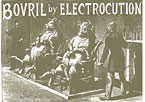
BOVRIL advertising 19C-
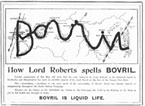
BOVRIL advertising 19C-

Chinese Calligram
Unknown period
Unknown period
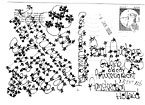
James Lee Byars (1932-1997)
Courtesy Gallery Paul Andriessen, Amsterdam
Postcard from Venice to his amsterdam gallery.1988
(Note that the address is very incomplete; No house number, no zipcode)
Courtesy Gallery Paul Andriessen, Amsterdam
Postcard from Venice to his amsterdam gallery.1988
(Note that the address is very incomplete; No house number, no zipcode)

Allan Graham-Toadhouse
Courtesy -Features Inc. NYC
2006; graphite on paper; 33 x 44 "
Courtesy -Features Inc. NYC
2006; graphite on paper; 33 x 44 "

Benoit Plateau
Courtesy Galerie Aline Vidal, Paris
Les galaxiens,2006
photo under plexiglass 207X137cm
Courtesy Galerie Aline Vidal, Paris
Les galaxiens,2006
photo under plexiglass 207X137cm

Juli Gudehus
The familiar story of the Creation is told by the author in the visual language of the 20th century.
Publisher: Lars Müller Publishers
ISBN-10: 3907044517
The familiar story of the Creation is told by the author in the visual language of the 20th century.
Publisher: Lars Müller Publishers
ISBN-10: 3907044517
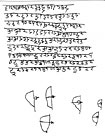
Korwa Drawing 1997
Courtesy Drawing Centre NYC
A tribe in Central India
Courtesy Drawing Centre NYC
A tribe in Central India

Altagor
Courtesy l’Enseigne des Oudins, Paris
(pseudonym of Jean Vernier) formerly a mechanic and miner, now writer of thrillers, created "Métapoésie poetry composed of invented words, therefore abstract. Sounds french, but isn't.
Courtesy l’Enseigne des Oudins, Paris
(pseudonym of Jean Vernier) formerly a mechanic and miner, now writer of thrillers, created "Métapoésie poetry composed of invented words, therefore abstract. Sounds french, but isn't.

Altagor
Courtesy l’Enseigne des Oudins, Paris
Courtesy l’Enseigne des Oudins, Paris
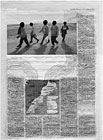
Tanja Smit
Drawing on El Pais
2005
Drawing on El Pais
2005
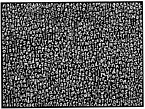
Gordon Terry
Courtesy G-module Paris
2004
Courtesy G-module Paris
2004

Jaap Blonk
Musical score
Musical score

Graffiti sketch
unknown artist,place or date
unknown artist,place or date
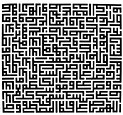
Koufi style geometric Quran laid in bricks
Iran 1303, Isfahan
Iran 1303, Isfahan

Graham Gillmore
'I'm sorry your having problems'
Courtesy Vanina Holasek Gallery, NYC
'I'm sorry your having problems'
Courtesy Vanina Holasek Gallery, NYC

Vincent van Gogh
-october 2 1888
Crossed out part of a letter about money to his brother Theo.
[letter 696] notice the little landscape in the background
-october 2 1888
Crossed out part of a letter about money to his brother Theo.
[letter 696] notice the little landscape in the background

Robert Walser (1878-1956)
In the beginning of 1929, Walser, who had suffered from anxieties and hallucinations for quite a time, went to the Bernese mental home Waldau, after a mental breakdown, at his sister Fani's urging. In his medical records it says: "The patient confessed hearing voices." Therefore, this can hardly be called a voluntary commitment. While in the mental home, his state of mind quickly returned to normal, and he went on writing and publishing. More and more, he used the way of writing he called the "pencil method": He wrote poems and prose in a diminutive Sütterlin hand( Sütterlin for short, is the last widely used form of the old German blackletter handwriting ("Spitzschrift"). In Germany, the old German cursive script developed in the 16th century is also sometimes called Fraktur the letters of which measured about a millimeter of height by the end of that very productive phase.) Werner Morlang and Bernhard Echte were the first ones who attempted to decipher these writings. In the 1990s, they published a six-volume edition, Aus dem Bleistiftgebiet ('From the pencil area'). Only when Walser was, against his will, moved to the sanatorium of Herisau in his home canton Appenzell Ausserrhoden, did he quit writing. Another reason might have been that with the rise of the Nazis in Germany, his works could no longer be published in any case. (source Wiki)

Carl Ferrero
2006
2006

Andre Masson 1896-1987
Chimeré 1944
Chimeré 1944

Lily van der Stokker
Difficult
Difficult

Olav Westphalen
Courtesy Maccarone Inc., NYC
(this english drawing should be pronounced with a german accent)
Courtesy Maccarone Inc., NYC
(this english drawing should be pronounced with a german accent)

Jaap Blonk
Musical score; Kré (hommage a A.A.)
Musical score; Kré (hommage a A.A.)

Leon Ferrari
Courtesy Drawing Centre NYC
Musica 1962
Courtesy Drawing Centre NYC
Musica 1962

Graham Gillmore
'I'm sorry your having problems'
Courtesy Vanina Holasek Gallery, NYC
'I'm sorry your having problems'
Courtesy Vanina Holasek Gallery, NYC
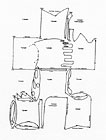
Anestis Logothetis (1921 — 1994)
these two scores belong on top of each other
Greek composer
these two scores belong on top of each other
Greek composer

Anestis Logothetis (1921 — 1994)
these two scores belong on top of each other
Greek composer
these two scores belong on top of each other
Greek composer

Cornelius Cardew (1936 —1981)
Treatise (1963-67),
Treatise (1963-67),
a 192-page graphic score which allows for considerable freedom of interpretation.
Following the demise of the Orchestra, Cardew became more directly involved in left-wing politics and abandoned avant-garde music altogether, adopting a populist though post-romantic tonal style. He spent 1973 in West Berlin on an artist's grant from the City, where he was active in a campaign for a children's clinic. During the 1970s, he produced many songs, often drawing from traditional English folk music put at the service of lengthy Marxist-Maoist exhortations; representative examples are Smash the Social Contract and There Is Only One Lie, There Is Only One Truth. In 1974, he published a book entitled Stockhausen Serves Imperialism, which denounced, in Maoist self-critical style, his own involvement with Stockhausen and the Western avant-garde tradition.(wiki)
Cornelius Cardew was killed on the 13th December 1981, by a hit and run driver near his home in East London. There's been conspiracies about involvement from the British secret service.
Following the demise of the Orchestra, Cardew became more directly involved in left-wing politics and abandoned avant-garde music altogether, adopting a populist though post-romantic tonal style. He spent 1973 in West Berlin on an artist's grant from the City, where he was active in a campaign for a children's clinic. During the 1970s, he produced many songs, often drawing from traditional English folk music put at the service of lengthy Marxist-Maoist exhortations; representative examples are Smash the Social Contract and There Is Only One Lie, There Is Only One Truth. In 1974, he published a book entitled Stockhausen Serves Imperialism, which denounced, in Maoist self-critical style, his own involvement with Stockhausen and the Western avant-garde tradition.(wiki)
Cornelius Cardew was killed on the 13th December 1981, by a hit and run driver near his home in East London. There's been conspiracies about involvement from the British secret service.

Marcus Raetz
Sketch for public sculpture in Bern
2002
Sketch for public sculpture in Bern
2002

Kinke Kooi
Courtesy Features inc. NYC
MAN 2004
coloured pencil on paper
Courtesy Features inc. NYC
MAN 2004
coloured pencil on paper

Korwa Drawing 1997
Courtesy Drawing Centre NYC
A tribe in Central India
Courtesy Drawing Centre NYC
A tribe in Central India
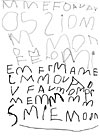
Eva Onnen
2006- Letter to the editor from niece (6 years)
The similarities withe the Korwa tribe drawings are stunning
2006- Letter to the editor from niece (6 years)
The similarities withe the Korwa tribe drawings are stunning

Richard Niessen
2005-Eye-vi typeface designed for Jennifer Tee
2005-Eye-vi typeface designed for Jennifer Tee
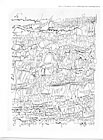
Leon Ferrari
1965
1965

Jaap Blonk
voice score
Transsiberian || Journey
voice score
Transsiberian || Journey
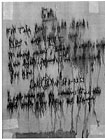
Unknown master
2007
For sale note found on street in Greenpoint-Brooklyn
2007
For sale note found on street in Greenpoint-Brooklyn

Robert Leighton
2007- Courtesy of The new yorker magazine/Cartoonbank
2007- Courtesy of The new yorker magazine/Cartoonbank

Allan Graham-Toadhouse
This body is taking this mind for a walk
Courtesy -Features Inc. NYC
2006; graphite on paper; 33 x 44 "
This body is taking this mind for a walk
Courtesy -Features Inc. NYC
2006; graphite on paper; 33 x 44 "
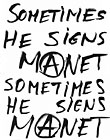
Alexandre Estrela
2003- Sometimes
2003- Sometimes

Unknown French
1900 - political cartoon
1900 - political cartoon

Gothic font S
15 Century French
15 Century French

Unknown internet
early ascii art
around 1987
early ascii art
around 1987
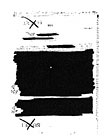
CIA
document-
document-

Shorthand typewriter
Passage from Hamlet, act three, scene one.
Is read from top to bottom and from left to right.
Passage from Hamlet, act three, scene one.
Is read from top to bottom and from left to right.

Azilian signary
coloured pebbles from Mas d'Azil, Ariége.
If this is text, then this might be the oldest of the world
(France)
coloured pebbles from Mas d'Azil, Ariége.
If this is text, then this might be the oldest of the world
(France)

Henry Chopin (1922-2008)

Jost Ammann
Family Tucker
hyrogravure
1589
Family Tucker
hyrogravure
1589

Ronde Tarentelle
French 19C
Rondo Alligretti; The tempo should double after every round
French 19C
Rondo Alligretti; The tempo should double after every round

Dick Raaijmakers
KWARTET (1971)
Courtesy V2, Rotterdam
KWARTET (1971)
Courtesy V2, Rotterdam

Charles Vreuls
ink on cardboard 10 cm x16 cm
ink on cardboard 10 cm x16 cm

Charles Vreuls
ink on cardboard 10 cm x16 cm
ink on cardboard 10 cm x16 cm
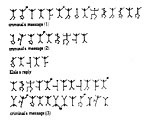
Sherlock Holmes/Arthur Conan Doyle
from the "The Adventure of the Dancing Men" in which Sherlock decrypts these mysterious messages as text
from the "The Adventure of the Dancing Men" in which Sherlock decrypts these mysterious messages as text

Sherlock Holmes/Arthur Conan Doyle
from the "The Adventure of the Dancing Men" in which Sherlock decrypts these mysterious messages as text
from the "The Adventure of the Dancing Men" in which Sherlock decrypts these mysterious messages as text

Daragh Reeves
Jeans & T-shirts 2007
Jeans & T-shirts 2007

Oorbeek /Klaas Kuitenbrouwer
music score 2007
music score 2007

Earle Brown
Music score-December 1952
Music score-December 1952

Bernard Requichot 1929-1961
'Lettre d'insultes 1961' les mots sont partis et les insultes restent'
Courtesy l’Enseigne des Oudins, Paris
'Lettre d'insultes 1961' les mots sont partis et les insultes restent'
Courtesy l’Enseigne des Oudins, Paris
'Requichot is a painter with a very nice ellidible written oeuvre; "ellidible-thank you lettre", "ellidible-lettres to artdealers", "ellidible-insulte lettres", "ellidible- lettre to art amateur" and "ellidible-lettre to framer"

Jean Luc Parant
Courtesy l’Enseigne des Oudins, Paris
"autoportrait 1998"
Courtesy l’Enseigne des Oudins, Paris
"autoportrait 1998"
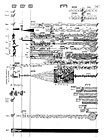
Jani Christou 1926 - 1970
score; Enantiodromia
www.janichristou.org
score; Enantiodromia
www.janichristou.org

Jeremy Everett
detail from;
All the declarations of war all the treaties of peace written in recent history
2007- Courtesy of Roberts & Tilton, Los Angeles
detail from;
All the declarations of war all the treaties of peace written in recent history
2007- Courtesy of Roberts & Tilton, Los Angeles

Jeremy Everett
detail from;
All the declarations of war all the treaties of peace written in recent history
2007- Courtesy of Roberts & Tilton, Los Angeles
detail from;
All the declarations of war all the treaties of peace written in recent history
2007- Courtesy of Roberts & Tilton, Los Angeles

Daragh Reeves
the teenager question 2007
the teenager question 2007

Guy Richards Smit
New York Times drawings 2005
Courtesy FRED (London)
New York Times drawings 2005
Courtesy FRED (London)

Guy Richards Smit
New York Times drawings 2005
Courtesy FRED (London)
New York Times drawings 2005
Courtesy FRED (London)

Quran caligram
unknown period and location
unknown period and location

Anneliese Coste
Courtesy Ellen de Bruijne Projects, Amsterdam
Courtesy Ellen de Bruijne Projects, Amsterdam
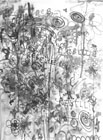
Anneliese Coste
Courtesy Ellen de Bruijne Projects, Amsterdam
Courtesy Ellen de Bruijne Projects, Amsterdam
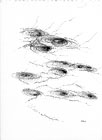
Ana Hatherly
Lisboa 20 Arte Contemporanea, Lisbon
Lisboa 20 Arte Contemporanea, Lisbon

Shin Moij-e Tsukushi 1751-1764
Fireworks
japanese
Fireworks
japanese

Victor Hugo (1802-1885)
Jersey. Victor Hugo, lived in exile in Jersey from 1852 to 1855 after getting into trouble with Napoleon |||
Jersey. Victor Hugo, lived in exile in Jersey from 1852 to 1855 after getting into trouble with Napoleon |||

Kellom Tomlinson
Dance notation 1727
Dance notation 1727

Dick Raaijmakers
KWARTET (1971)
Courtesy V2, Rotterdam
KWARTET (1971)
Courtesy V2, Rotterdam

French Rebus 1859
These extremely difficult rebuses where very popular in illustrated magazines around 1840-1890.
This one means; "En general les enfants ont peur de l'eau"
'in general children are afraid of the water' (in french these words all sound alike; l'eau, l'haut, l'os, lot)
These extremely difficult rebuses where very popular in illustrated magazines around 1840-1890.
This one means; "En general les enfants ont peur de l'eau"
'in general children are afraid of the water' (in french these words all sound alike; l'eau, l'haut, l'os, lot)

Max Ernst
drawing
drawing
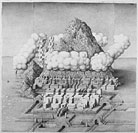
Paul Noble
Public Toilet
pencil on paper
242 x 252 cm
1999
Public Toilet
pencil on paper
242 x 252 cm
1999

Jaap Blonk
Rhotic - Fonetische etude nr.1
Rhotic - Fonetische etude nr.1
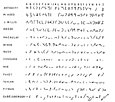
13 different shortands
from antiquity till present day (pitman).
from antiquity till present day (pitman).
Shorthand is an abbreviated and/or symbolic writing method that increases speed or brevity of writing as compared to a normal method of writing a language. The process of writing in shorthand is called stenography, from the Greek stenos (narrow) and graphē (writing). It has also been called brachygraphy, from Greek brachys (short) and tachygraphy, from Greek tachys (swift, speedy), depending on whether compression or speed of writing is the goal. Many forms of shorthand exist. A typical shorthand system provides symbols or abbreviations for words and common phrases, which allow someone well trained in the system to write as quickly as people speak.
Shorthand was used more widely in the past, before the invention of recording and dictation machines. Until recently, shorthand was considered an essential part of secretarial training as well as being useful for journalists. Although the primary use of shorthand has been to record oral dictation or discourse, some systems are used for compact expression. For example, health-care professionals may use shorthand notes in medical charts and correspondence. Shorthand is also common in the food service industry, allowing wait staff to write down detailed orders without delay.
Shorthand was used more widely in the past, before the invention of recording and dictation machines. Until recently, shorthand was considered an essential part of secretarial training as well as being useful for journalists. Although the primary use of shorthand has been to record oral dictation or discourse, some systems are used for compact expression. For example, health-care professionals may use shorthand notes in medical charts and correspondence. Shorthand is also common in the food service industry, allowing wait staff to write down detailed orders without delay.

Leon Ferrari
1979
1979

Carl Ferrero
2006
2006

Réne Daniels
Courtesy Gallery Paul Andriessen, Amsterdam
'Two i's fighting for a point under a rain of explanation marks'
Twee i's vechten om een punt onder een regen van uitroepstekens'
Courtesy Gallery Paul Andriessen, Amsterdam
'Two i's fighting for a point under a rain of explanation marks'
Twee i's vechten om een punt onder een regen van uitroepstekens'